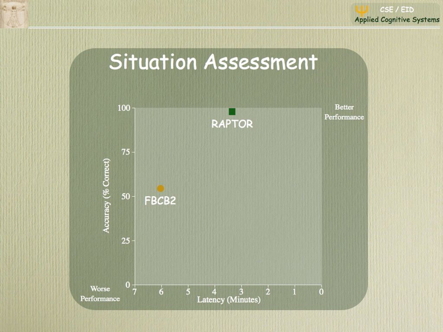
Recent Award WinnerEcological Interface Design:Military Command & ControlDr. Bennett and his colleagues have applied the Cognitive Systems Engineering approach to the development of an Ecological Interface Designed to support decision making and problem solving during ground based tactical operations. The "RAPTOR" (Representation Aiding Portrayal of Tactical Operations Resources) interface is intuitive and highly graphical and includes the following unique and innovative displays:
The CSE / EID analyses and design rationale for the RAPTOR interface are described in Bennett, Posey, & Shattuck (2008) [click here to download] The capstone evaluation of this interface is described in Hall, Shattuck, & Bennett (2012) [click here to download] The RAPTOR interface was compared to an existing Army interface in a capstone evaluation. Veteran officers were engaged in realistic simulations of tactical engagements. Performance was significantly better with RAPTOR for 6 of the 7 dependent measures. Some of these dramatic differences are illustrated to the right (situation assessment). This work received the award for the most outstanding article published in the 2012 Journal of Cognitive Engineering and Decision Making [click here for details]. This research was funded by the Army Research Laboratory, first through the FEDLAB program, and then through the Advanced Decision Architectures Collaborative Technology Alliance (ARL ADA CTA). One of our early publications describe Perception / Action Icons (Talcott, Bennett, Martinez, Stansifer, & Shattuck, 2007 [click here to download]). © Kevin B. Bennett, all rights reserved phone: 937-775-2444 |
RAPTOR Interface: Primary controls and displays (Bennett, Posey, and Shattuck, 2008)
Veteran officers using the RAPTOR Interface completed situation assessment tasks in approximately half the time and with twice the accuracy relative to an existing Army interface (Hall, Shattuck, and Bennett, 2012).
|
|

